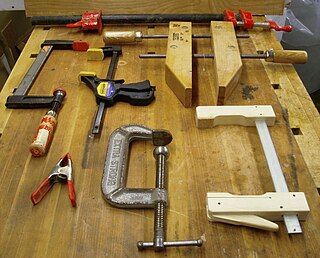
A clamp is a fastening device used to hold or secure objects tightly together to prevent movement or separation through the application of inward pressure. In the United Kingdom the term cramp is often used instead when the tool is for temporary use for positioning components during construction and woodworking; thus a G cramp or a sash clamp but a wheel clamp or a surgical clamp.
The Liebig condenser or straight condenser is a piece of laboratory equipment, specifically a condenser consisting of a straight glass tube surrounded by a water jacket.

Standard diving dress, also known as hard-hat or copper hat equipment, deep sea diving suit or heavy gear, is a type of diving suit that was formerly used for all relatively deep underwater work that required more than breath-hold duration, which included marine salvage, civil engineering, pearl shell diving and other commercial diving work, and similar naval diving applications. Standard diving dress has largely been superseded by lighter and more comfortable equipment.

A diving helmet is a rigid head enclosure with a breathing gas supply used in underwater diving. They are worn mainly by professional divers engaged in surface-supplied diving, though some models can be used with scuba equipment. The upper part of the helmet, known colloquially as the hat or bonnet, may be sealed directly to the diver using a neck dam, connected to a diving suit by a lower part, known as a breastplate, or corselet, depending on regional language preferences. or simply rest on the diver's shoulders, with an open bottom, for shallow water use.

The voltage clamp is an experimental method used by electrophysiologists to measure the ion currents through the membranes of excitable cells, such as neurons, while holding the membrane voltage at a set level. A basic voltage clamp will iteratively measure the membrane potential, and then change the membrane potential (voltage) to a desired value by adding the necessary current. This "clamps" the cell membrane at a desired constant voltage, allowing the voltage clamp to record what currents are delivered. Because the currents applied to the cell must be equal to the current going across the cell membrane at the set voltage, the recorded currents indicate how the cell reacts to changes in membrane potential. Cell membranes of excitable cells contain many different kinds of ion channels, some of which are voltage-gated. The voltage clamp allows the membrane voltage to be manipulated independently of the ionic currents, allowing the current–voltage relationships of membrane channels to be studied.

A volumetric flask is a piece of laboratory apparatus, a type of laboratory flask, calibrated to contain a precise volume at a certain temperature. Volumetric flasks are used for precise dilutions and preparation of standard solutions. These flasks are usually pear-shaped, with a flat bottom, and made of glass or plastic. The flask's mouth is either furnished with a plastic snap/screw cap or fitted with a joint to accommodate a PTFE or glass stopper. The neck of volumetric flasks is elongated and narrow with an etched ring graduation marking. The marking indicates the volume of liquid contained when filled up to that point. The marking is typically calibrated "to contain" at 20 °C and indicated correspondingly on a label. The flask's label also indicates the nominal volume, tolerance, precision class, relevant manufacturing standard and the manufacturer's logo. Volumetric flasks are of various sizes, containing from a fraction of a milliliter to hundreds of liters of liquid.

The dumbbell, a type of free weight, is a piece of equipment used in weight training. It is usually used individually or in pairs, with one in each hand.

External fixation is a surgical treatment wherein Kirschner pins and wires are inserted and affixed into bone and then exit the body to be attached to an external apparatus composed of rings and threaded rods — the Ilizarov apparatus, the Taylor Spatial Frame, and the Octopod External Fixator — which immobilises the damaged limb to facilitate healing. As an alternative to internal fixation, wherein bone-stabilising mechanical components are surgically emplaced in the body of the patient, external fixation is used to stabilize bone tissues and soft tissues at a distance from the site of the injury.

In medicine, the Ilizarov apparatus is a type of external fixation apparatus used in orthopedic surgery to lengthen or to reshape the damaged bones of an arm or a leg; used as a limb-sparing technique for treating complex fractures and open bone fractures; and used to treat an infected non-union of bones, which cannot be surgically resolved. The Ilizarov apparatus corrects angular deformity in a leg, corrects differences in the lengths of the legs of the patient, and resolves osteopathic non-unions; further developments of the Ilizarov apparatus progressed to the development of the Taylor Spatial Frame.

A nipple clamp is a type of sex toy that is applied to a person's nipples to pinch them. Varieties of nipple clamp include clothes-pin-style, tweezer and clover. Nipple clamps are used to cause pain in the nipples as part of certain BDSM activities. They are also used to produce erotic stimulation as part of nipple play. In this context they are not primarily used to produce pain but rather to increase nipple sensation. Their use traps blood in the nipples, increasing the sensitivity of the nipple. The sexologist Carol Queen says that "clamps are also very useful for hands-free nipple play".

A vise or vice is a mechanical apparatus used to secure an object to allow work to be performed on it. Vises have two parallel jaws, one fixed and the other movable, threaded in and out by a screw and lever.
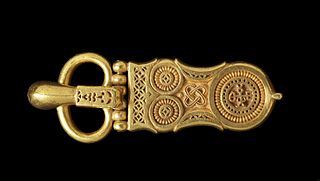
A belt buckle is a buckle, a clasp for fastening two ends, such as of straps or a belt, in which a device attached to one of the ends is fitted or coupled to the other. The word enters Middle English via Old French and the Latin buccula or "cheek-strap," as for a helmet. Belt buckles and other fixtures are used on a variety of belts, including cingula, baltea, baldrics and later waist-belts.
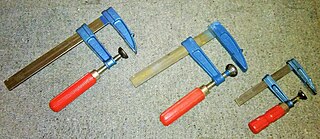
An F-clamp, also known as a bar clamp or speed clamp, is a type of clamp. The name comes from its "F" shape. This tool is used in woodworking while more permanent attachment is being made with screws or glue, or in metalworking to hold pieces together for welding or bolting. F-clamps are similar to but distinct from C-clamps and pipe clamps.

Vacuum filtration is a fast filtration technique used to separate solids from liquids.
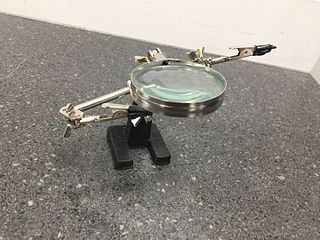
A helping hand, also known as a third hand, soldering hand, or X-tra Hands, is a type of extremely adjustable jig used in soldering and craftwork to hold materials near each other so that the user can work on them.

In chemistry, a retort stand, also called a clamp stand, a ring stand, or a support stand, is a piece of scientific equipment intended to support other pieces of equipment and glassware — for instance, burettes, test tubes and flasks.

An iron ring or ring clamp is an item of laboratory equipment which comprises a conjoined metal ring and radially-extending rod. In some cases, the rod terminates in a screw clamp for attachment to a retort stand or other support; in others, the rod may be attached to a stand by means of a laboratory clamp holder. Iron rings are commonly used in chemistry laboratories for supporting apparatus above the work surface, for example:
Temporary adjustments are a set of operations which are performed on a theodolite to make it ready for taking observations. These include its initial setting up on a tripod or other stand, centering, levelling up and focusing of eyepiece.
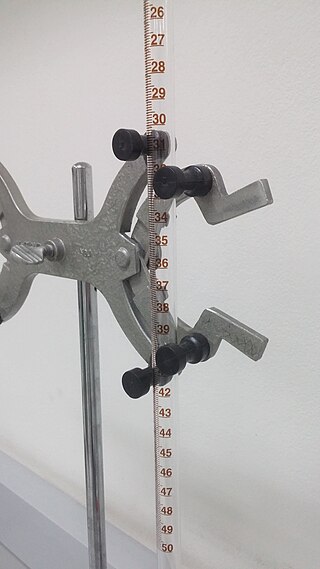
Burette clamp is a scientific equipment which used specifically to hold and secure a burette on a stand, so that a burette is fixed and more convenient for the experiment. Burette clamps can be made with many materials such as plastic and cast iron. However, an iron clamp with a rubber knob to hold the burette are usually more durable. Usually burette clamps come in doubles, which means they can hold two burettes.

A clamp holder or clamp fastener is a piece of laboratory apparatus that is used to secure laboratory clamps, such as extension-type utility clamps, or other attachments to a retort stand or lab frame. The material can be made up of brass, cast iron, stainless steel, aluminium or nickel-plated zinc.




















